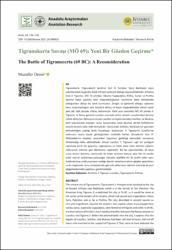Tigranokerta Savaşı (MÖ 69): Yeni Bir Gözden Geçirme
Citation
Demir, M. (2021). Tigranokerta savaşı (Mö 69): Yeni bir gözden geçirme. Anadolu Araştırmaları-Anatolian Research, 24, 145–176. https://doi.org/10.26650/anar.2021.24.898025Abstract
The ancient city of Tigranocerta (Tigranakert) is thought to be localized to the site of Ancient A/Erzen near Bozhöyük, which is in the district of Siirt Province. The Armenian king, Tigranes II, established this city in 76 BC, as it would be more at the center of the borders of his empire, which had spread over Cappadocia, Cilicia, Syria, Palestine, and as far as Parthia. This city, described in ancient sources as rich and magnificent, became the empire’s new capital, where many people from various areas, especially Cappadocia, were forced to immigrate and settle. In 69 BC, it witnessed one of history’s most significant battles between the Roman proconsul Lucullus and Tigranes II. Before the pitched battle near the city, it appears that the legates of Lucullus, Sextilius, and Murena had been sent out to harass and cut off those who marched to the support of Tigranes II. They seem to have defeated the enemy in all these engagements. Eventually, Sextilius started to besiege Tigranocerta, where Mankaios was in command. As the size of the Roman army appeared inconsiderable to Tigranes II and his allies, even jeering at it, they did not listen to the advice of their ally, Mithradates VI, the king of Pontus (Black Sea), to try and cut off the supplies of the Roman army. They instead preferred to engage in a pitched battle, where they were heavily defeated by Lucullus. Thus, Tigranocerta fell and was sacked, and the city’s immigrant population was sent back to their homes. In this article, we first explain the circumstances before the battle and then concentrate on the question of army size on both sides, which appears to have been exaggerated by some ancient writers, and finally reevaluate their battle strategies within this conjecture.


















